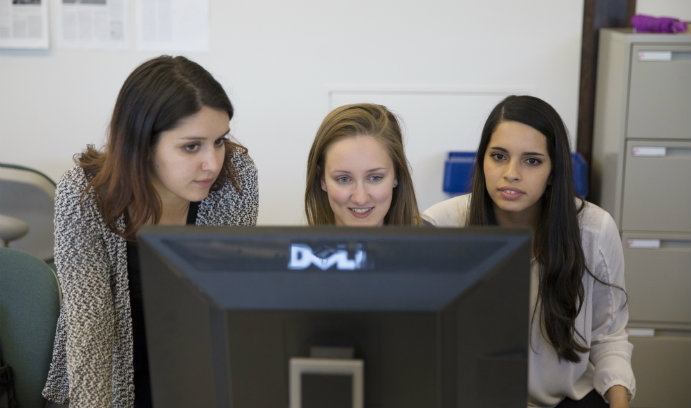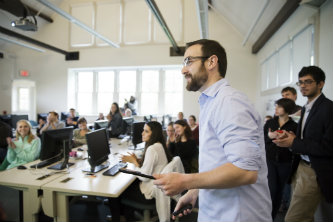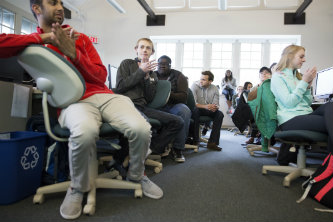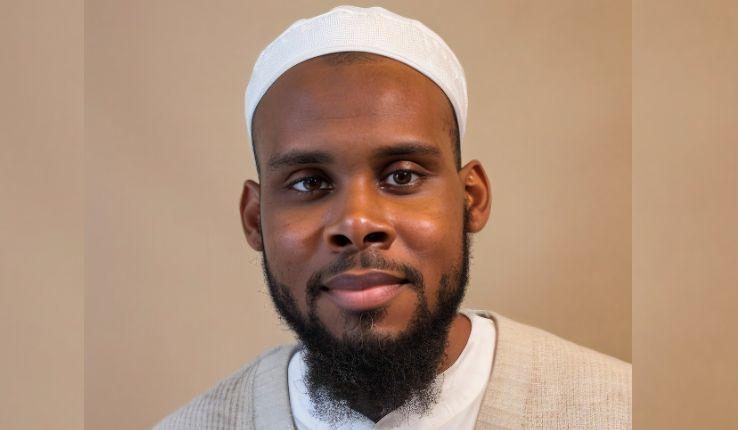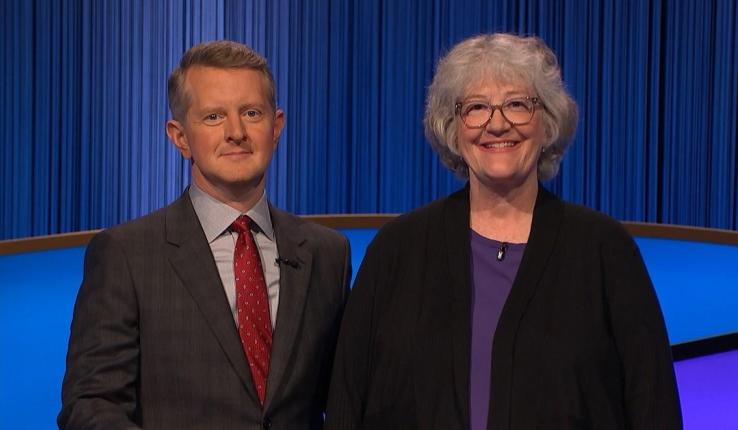'Go Forth and Journalism'
The staff of The Brown and White breaks news and embraces the challenges and camaraderie of journalism.
Nobody expected the bus accident.
Those on the brown-and-white bus carrying members of Lehigh’s rowing team certainly didn’t see it coming. Neither did members of the editorial staff of Lehigh’s student newspaper, The Brown and White, who found themselves stuck in the resulting traffic on Route 22 when the call came in.
Other staff members driving in the opposite direction on the same road had just passed the accident scene and called their editors. They shared what they’d witnessed—a Lehigh bus, overturned in the westbound lanes.
“That’s when we went into breaking news mode,” says Samantha Tomaszewski ’17, then the news editor.
Throughout that night in October 2015, the newspaper staff made phone calls, conducted interviews and broke stories online. The coverage won recognition by the Keystone Student Press Awards, one of many accolades received in recent years by a team that says awards are a nice bonus but not the reason they do what they do.
In publication since 1894, The Brown and White now embraces the 24/7 mindset of today’s journalists, telling stories through social media and online publication in addition to print. A number of the paper’s writers and editors have gone on to successful journalism careers, most notably Pulitzer Prize winners Joe Morganstern ’53, film critic for The Wall Street Journal, and Marty Baron ’76, current executive editor of The Washington Post. Whether or not they will eventually become professional journalists, the members of The Brown and White’s staff commit themselves fully to reporting all the Lehigh news first.
Breaking the news
After learning of the accident, the team returned to campus, to their newsroom on the third floor of Coppee Hall. They quickly discovered that the Lehigh Athletics bus carried 18 members of the rowing team on their way to practice. Another driver had hit the bus from behind at a high rate of speed, flipping it onto its roof. The driver of the car was killed in the crash; the Lehigh students and the bus driver sustained minor injuries.
There wasn’t a press run the night of Oct. 27; the newspaper is published on Tuesdays and Fridays during the academic year. But the staff nonetheless worked through the night, making phone calls, soliciting information and posting updates on the paper’s website and on social media as they learned new details. They used their personal connections as students to capture the voice of those involved and maintained contact with the state trooper they’d connected with earlier in the evening. They were reporting information before any other media outlet. They were breaking the news.
A reporter from a larger local news outlet called the newsroom and spoke to Danielle DiStefano ’16, then editor-in-chief, asking about how The Brown and White was getting its information.
“When I was a younger editor, it was more of a ‘Let’s see what local news outlets are doing and maybe follow their lead,’” says DiStefano, who double majored in journalism and marketing. “[But] the bus accident just sort of fell into our lap. ... We did everything first. It was a really unique experience for The Brown and White to lead that.”
“It was not an event we were happy to cover, but ... it was the first time that news that wasn’t just kind of niche-y Lehigh news happened in such a way that it was breaking,” says Jacqueline Tenreiro ’16, who served as editor-in-chief in spring 2016.
Throughout their coverage, The Brown and White team bore in mind the trauma those involved in the accident had experienced.
“We talked along the way: ‘Don’t forget that someone died in this story, this is where that discussion of empathy in journalism comes into play,’” says Matt Veto, professor of practice in journalism and communication and adviser to The Brown and White. “They just did a spectacular job of handling that carefully and doing it in an ethical and principled way.”
‘You’re always learning from somebody’
Students run The Brown and White. They choose the stories, pursue the leads, write and edit. Veto provides the framework of how a newsroom should run and assists with occasional logistics, but The Brown and White is the students’ paper to operate, as it has been since the paper’s inception more than 120 years ago.
“I don’t touch the content,” says Veto. “I don’t know what stories they’re going to write until they write them.”
When Veto arrived at Lehigh in spring 2014, he implemented changes to the paper that would prove essential in the paper’s coverage of the bus accident and other breaking news. He overhauled The Brown and White’s production process, restructured positions and reorganized the brainstorming procedure. The newspaper got its own website after years of partnering with lehighvalleylive.com. Students can now more easily use multimedia in their storytelling and have ready access to analytics. Social media has become a major focus.
Gaby Morera ’17, a journalism major who served as editorial pages editor in spring 2016 and will be co-managing editor in the fall, says the changes helped increase communication among the staff and encouraged writers and editors to “step it up.” Consequently, she says, over the past several years, individual members of the newspaper staff and the editorial team as a whole have been recognized with multiple awards in Pennsylvania and two nationally (see sidebar).
Veto meets with the paper’s 37 editors on Wednesdays to provide a critique of the previous week’s issues. Students also critique themselves and meet to discuss analytics and the upcoming issue. Editors then read the stories submitted from their pool of 69 reporters and send them through the chain of command to the editor-in-chief.
“When someone is so obviously passionate about something, it makes you more excited to learn about it as well,” says Becca Bednarz ’15 of Veto. Bednarz, a journalism major who was managing editor in fall 2014, won a Pinnacle Award for her editorial work as well as two Keystone awards: one for editorial and an honorable mention for public service reporting. Her public service reporting also took first place in the Society of Professional Journalists (SPJ) Mark of Excellence Awards.
“[Veto] gives us all the autonomy while contributing when he knows that we need it,” says DiStefano, who also stresses the care and support of the faculty members in the department of journalism and communication. “To know that they’re just as committed to our cause as we are is a huge deal for us.”
Morera, who won first place for her personality profile of alumna Lisa Glover in the Keystones and an honorable mention in the Society of Professional Journalists Mark of Excellence Awards for column writing, is quick to highlight that mentorship occurs among students as well.
“I feel like I’ve mentored people who are younger than me, but I also feel like people above me have been mentors. I’ve learned from them and how they lead the newspaper and the stuff they do and how they write,” she says. “You’re always learning from somebody.”
‘It’s our job to do this’
The Brown and White isn’t an activity one commits to half-heartedly. Press nights—Sundays and Wednesdays—see students on the third floor of Coppee Hall from 4 p.m. to as late as 1 a.m. and from noon to 9 p.m., respectively.
“That’s the equivalent of a part-time job, but it’s something that I enjoy, so I don’t even think of it as a job,” says Austin Vitelli ’17, who served as sports editor in spring 2016 and will be co-managing editor next fall. Vitelli’s story on football attendance at Lehigh and other colleges placed second for best sports story in the Keystones. “The Brown and White is my favorite part of my experience at Lehigh.”
“It takes up our whole lives. We’re dedicated to it 24/7,” says Tomaszewski.
That buy-in, says Veto, makes his job as adviser an easy one.
“I know they’re going to be working hard with making sure that things are fair, accurate and as objective as possible with the information they have. They take it upon themselves to find big, issue-based stories, things that they know their peers care about and want to talk about. They’re not afraid to tell those stories, either, and sometimes those are sensitive topics. They do a really good job of practicing that empathy that we talk about in journalism and turning around good stories,” he explains.
During the 2015-2016 academic year alone, The Brown and White has tackled stories on Greek life, rape culture, the relationship between the university and Bethlehem, prescription pill abuse on college campuses and domestic violence.
Students earn one or two course credits for participation, but most are in it for more. DiStefano, whose grandfather was the newspaper’s business manager when he was a Lehigh student, signed up for The Brown and White “on a whim” as a freshman. She describes her first story, a last-minute assignment covering a campus blood drive: “I had no idea what I was doing, and then that was it. I was hooked.”
The Brown and White’s approach to production, she says, “make[s] it known to people that this is a real responsibility, and that we’re doing something because we care about journalism, not because we care about the grade.”
When her tenure as editor-in-chief ended, DiStefano continued on in a different capacity, advising first-year reporters and guiding them through the process of writing for The Brown and White.
“I never dreaded [press night]. I always looked forward to it. ... [Now] I try to find ways to be there... [I ask], ‘Does anyone need me today for any reason?’” she says with a laugh.
“We feel this sense of responsibility: it’s our job to do this,” says Tomaszewski, a journalism and political science double major who will be the newspaper’s editor-in-chief in fall 2016.
‘Like a family’
Although most Brown and White editors study journalism, the staff includes many students from a variety of academic backgrounds. This variety makes for interesting collaboration—and one big family.
“Sixty-five percent of our whole operation is from outside of journalism,” says Veto. “We’ve got a lot of different people, which is great, because I think it improves the dynamic overall. And I love to see the work that they put together.”
Given the amount of time they spend together, staff members become close.
“I don’t really think there’s anything that unites people like sharing a common passion, working towards a common cause,” says Tomaszewski. “The fact that we spend press night two times a week for almost 20 hours combined and then we have extra editorial meetings twice a week, we’re basically seeing each other every day and learning how each other works and functions. Our personal lives bleed through by proxy, just by being around each other so much.”
“It’s more like a family for us, and that sounds corny but actually I think that’s why we do so well,” says DiStefano. “We want to spend so much time there because we actually enjoy each other’s presence. ... We spend time together outside of class all the time.”
A deep sense of respect and teamwork permeates the group, an all-for-one and one-for-all attitude that continues beyond commencement.
“[The awards have] been a very humbling and honoring experience. It’s been incredible,” says Bednarz, whose work was recognized after she graduated. “The staff is so high-caliber, and I really don’t think any of the awards I won personally would have been possible without any of them.”
‘Go forth and journalism’
Veto often tells his students to “go forth and journalism.”
Some, upon graduating, will do just that. Others will explore other career paths, armed with the skills they’ve developed working on The Brown and White. Breaking news, personality profiles and event coverage have shaped them as journalists and as individuals.
“I am indescribably proud,” says Veto. “They do excellent work. ... And whether or not they choose journalism, the skills that they learn as communicators—and especially our editors who are working as managers—that’s all transferable to any discipline. Employers everywhere are looking for people who can put two words together, and they can do more than that.”
Video and photos by Stephanie Veto
Posted on:


